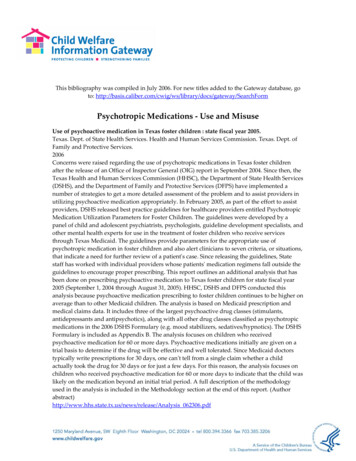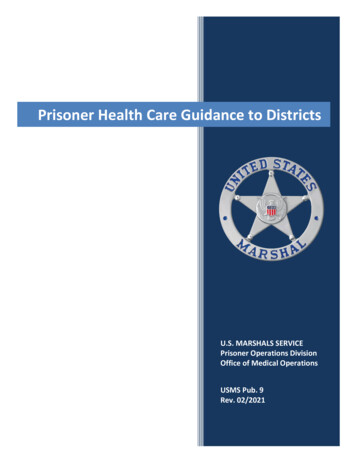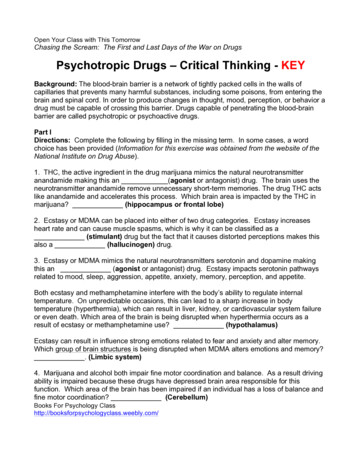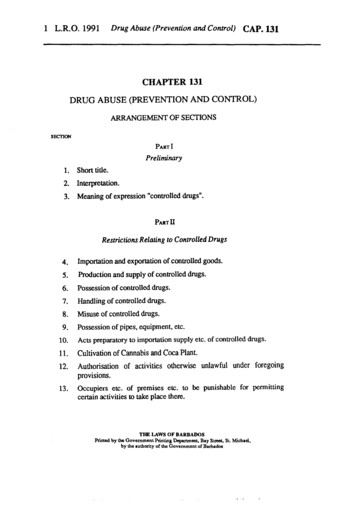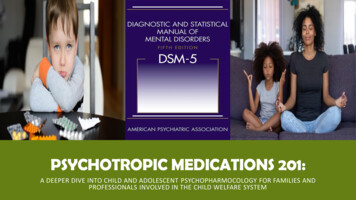
Transcription
PSYCHOTROPIC MEDICATIONS 201:A DEEPER DIVE INTO CHILD AND ADOLESCENT PSYCHOPHARMOCOLOGY FOR FAMILIES ANDPROFESSIONALS INVOLVED IN THE CHILD WELFARE SYSTEM
DIFFICULT ISSUESChildren in the child welfare system are prescribed psychotropicmedications at rates up to three to four times higher than rates for otherMedicaid-insured youth.
ABOUT KRISTOPHER KALIEBE, MDo Grew up in Tampao Board Certified in Psychiatry, Forensic Psychiatry and Child andAdolescent Psychiatryo Associate Professor of Psychiatry at the University of South Floridao Clinical experience has been in Federally Qualified Health Centers(public community clinics) and Juvenile Corrections
ABOUT CATAROLYN M. GLENN, MAo Born and raised in Tampao Education: Florida State University & Argosy Universityo 11 years of Child Welfare experience (Case Manager, FDS, Licensing, ChildWelfare Trainer)o 6 years as a Marriage & Family Therapist providing counselingservices to children & families in the Child Welfare systemo Currently the Licensing and Development Facilitator withinFlorida’s Center for Child Welfare at the University of South Florida
OBJECTIVES Review advances in terminology and nomenclatureregarding psychotropic medications Review selected best practice for the most commonmedications used for ADHD, Autism, disruptive behaviors,mood and anxiety disorders. Identify strategies for augmentation of medications withnutritional approaches
OPENING QUESTIONS1. What are your experienceswith psychotropic medicationwithin the dependency caresystem?2. What are your successesand/or frustrations?3. What would you like tolearn?
CommunicationDiagnosisRecords andbillingInterventions
DIAGNOSIS-THE IDENTIFICATION OF THENATURE OF AN ILLNESS OR OTHER PROBLEM BYEXAMINATION OF THE SYMPTOMS.OXFORD LANGUAGESQuestions arise:1.When is a medical name important to clarify a problems?2. When can it be counterproductive to use a medical illness approachfor the emotional, cognitive and behavioral challenges of children?3. In the dependency care system, do the symptoms reveal "thenature of an illness"?
DIAGNOSIS-THE IDENTIFICATION OF THE NATUREOF AN ILLNESS OR OTHER PROBLEMBY EXAMINATION OF THE SYMPTOMS. OXFORDLANGUAGESExperts are moving away from diagnosis-based practice towardecological / systems based approaches.See NIMH – Research Domain CriteriaBrain science has generally moved beyond the DSM V naming system,yet has not yet provided a better language to discuss these problemsDespite this – I will use the common names of “disorders” as framed in the DSM VWhile this is not ideal, it’s the best we can do currently
PSYCHOTROPIC MEDICATIONCATEGORIES
OLD DRUG CLASSIFICATIONSA. AntipsychoticsB. AntidepressantsC.Mood StabilizerD. ADHD medication (stimulants)E.Non-stimulant ADHD medicationF.Anti-dementia medicationsG. Sedatives
BIPOLAR DISORDER Antipsychotics:LatudaRisperdalZyprexaAbilify Mood Stabilizers ctal Minerals: Lithium
NEUROSCIENCE-BASED NOMENCLATURE( NBN)See: NBN official app- aims to bring the clinician a state-ofthe-art nomenclature system regarding the use ofpsychotropic drugs in children and adolescents.“The current pharmacological nomenclature does not reflectcontemporary knowledge nor does it appropriately inform theclinician of neuroscience-based prescribing.The nomenclature is confusing to patients as well, for instancewhen an antidepressant is prescribed for anxiety, or a secondgeneration antipsychotic to a depressed patient.”
NEUROSCIENCE-BASED NOMENCLATURE(FORMERLY ANTIDEPRESSANTS)A. Serotonin Reuptake Inhibitors (Sertraline, Fluoxetine, Escitalopram)B.Serotonin and Norepinephrine Reuptake Inhibitors (Effexor)C.Serotonin modulation (trazodone, trintillix)D. Norepinephrine Reuptake Inhibitor (nortryptaline)E.Norepinephrine and dopamine modulation (Bupropion)F.Serotonin and Norepinephrine modulation (Mirtazapine)
NEUROSCIENCE-BASED NOMENCLATURE(FORMERLY MOOD STABILIZERS ) Lamictal: lamotrigine, glutamate channel blocker. Valproic acid (Depakote)- glutamate modulator, with unclear mode ofaction, causes inositol depletion and decreases brain cyclic AMP topiramate (Topamax), modulates GABA and glutamate Lithium: effects all brain regions, effects multiple neurotransmitters andinter-cellular pathways
NEUROSCIENCE-BASED NOMENCLATUREFORMERLY ADHD MEDICATIONSA. Amphetamine - Dopamine and Norepinephrine modulator(Release)B. Methylphenidate - Dopamine and Norepinephrine (Reuptake blocker)C.Norepinephrine reuptake inhibitor (atomoxetine)D. Norepinephrine (Alpha 2 receptor) agonist (clodidine and guanfacime)E.Caffeine - adenosine receptors antagonist, inhibits phosphodiesterase
NEUROSCIENCE-BASED NOMENCLATUREFORMERLY ANTI PSYCHOTICA. Dopamine antagonists (haloperidol)B. Dopamine and Serotonin antagonist (olanzapine, risperidone)C.Dopamine and Serotonin partial agonist (aripiprazole)D. Dopamine and serotonin and Norepinephrine Reuptake Modulator(quetiapine)
NON-DRUG CHEMICALS WITH BRAIN EFFECTSA. Nutritional Fats - Omega 3 Fatty Acid, Omega 6 Fatty acids, etcB. Vitamins – B6, B12, C, E, etcC.Hormones – Vitamin D, melatonin, thyroid and sex homoneD. Hormone Disrupters – Bisphenol A, Phthalates, etcE.Minerals – Magnesium, Zinc, Copper, LithiumF.Artificial Colors - Yellow 5, Yellow 6, and Red 40G. PreservativesH. Heavy Metals – Lead, mercury, etcI.Artificial Sweeteners
DISRUPTIVE MOOD DYSREGULATIONDISORDER Disruptive Mood Dysregulation Disorder (DMDD), new in DSM V –can only be given to a child between 6-18 yrs. Children may have ADHD or Depression in addition to the DMDDdiagnoses. The DMDD diagnosis was added in part to decrease the number ofchildren diagnosed with bipolar disorder.
DISRUPTIVE MOOD DYSREGULATIONDISORDER ADHD medications Antidepressant medications Bipolar Disorder MedicationsRecommended to be try the ADHD medication and/or antidepressant before theBipolar Disorder medication
AUTISM AND SERIOUS BEHAVIORPROBLEMS The trials of medicines for Autism Spectrum Disorder inform treatmentof children with other neurodevelopmental disorders (such as ADHD,Fetal Alcohol Syndrome, genetic or chromosomal disorders, affectivedisorders as a result of trauma.)The approach with mild patients (formerly Aspergers) is very differentthan with severe autism.
AUTISM STUDIESRisperidone has FDA approval in children as young as 5 years of age for irritabilityassociated with autistic disorder Omega-3 FA and 8 psychotropic meds each have 1 Randomized Controlled Trialshowing symptom improvement. Medications used with a high level of evidence to target specific behaviors:o Aggression/irritability – Risperdal, Aripiprazole, Topiramateo Hyperactivity/inattention – Methylphenidate, Risperdal, Aripiprazole, Atomoxetineo Stereotypy/repetitive behaviors – Risperdal, Aripiprazole, Fluoxetine
ANXIETYo 4-7 % of children (Cochran review 2010, # 6)o Most children who meet criteria for one anxiety disorder have multiple: The“number needed to treat” was approximately 4o The majority of adult anxiety disorders begin in childhood and are stable andoften chronico Meta-analysis(Ipser): response rate to medication 58%, response rate to placebo32%o Evidence base for SRI is good.
POST TRAUMATIC STRESS DISORDER“PTSD” There is no clear evidence for the use of meds in PTSD inchildren and adolescents (medicines are not better thanplacebo). Psychotherapy is the treatment of choice. What to do when therapy is refused, doesn’t help or isunavailable? Post Traumatic growth: personal strength; socialrelationships; appreciation for life; identification of newpossibilities; and changes to spirituality
POST TRAUMATIC STRESS DISORDER“PTSD” Prazosin 1-8mg in children and adolescent. Propranolol as an adjunct to therapy Micronutrient Combinations have interesting evidence Other medications to control symptoms when needed
DEPRESSION FDA Approved: only Prozac (8 and up) and Lexapro (12 and up) A recent review found only Prozac effective Medications for depression in BOTH adults and children generallyslightly better than placebo It is best to use anti-depressants only for moderate / severedepression (but in clinical practice are frequently used for milddepression)
PSYCHOTROPIC MEDICATIONFINDING INFORMATION
Marcus Aurelius: If we cannot resist pleasures, we will end up playing the role of slaveMODERN OVERCONSUMPTION DILEMMAS Highly palatable food (sugar) Video Games Social Media Television Substance abuse
TEAM APPROACHPlanningMonitoringAuthorization
Child Welfare ProfessionalsupervisorCaregiverChild WelfareProfessionalPhysician/Designee
PARENT OR LEGAL GUARDIANINVOLVEMENT THE CHILD WELFARE PROFESSIONAL SHOULD FACILITATE THE ATTENDANCE OF THE CHILD’S PARENT(WHERE PARENTAL RIGHTS ARE INTACT) THE CHILD’S PARENT OR LEGAL GUARDIAN SHOULD PROVIDE EXPRESSED AND INFORMED CONSENT THE CHILD WELFARE PROFESSIONAL SHOULD ASSIST WITH OBTAINING CONSENT VIA: Attempts to invite the parent or legal guardian to the appointment Facilitate transportation (if needed) Facilitate telephone or tele-medicine participation If the parent is unable to attend the Child Welfare Professional should Attempt to contact the parent or legal guardian & Provide how and when to contact thephysician/designee Provide the medical report (which includes physician contact info) to the parent or legal guardian ONCE AUTHORIZED BY THE COURT, THE CHILD WELFARE PROFESSIONAL MUST CONTINUE TO TRY TOINVOLVE AND FACILITATE COMMUNICATION WITH THE PARENT OR GUARDIAN AND PHYSICIAN SOTHAT PARENT/GUARDIAN HAS THE OPPORTUNITY TO AUTHORIZE THE PROVISION OF ANY NEWMEDICATIONS OR DOSAGESSource 65C35.003
CAREGIVER INVOLVEMENT ATTEND MEDICAL APPOINTMENTS EXPRESS CONCERNS REGARDING PRESCRIBINGPSYCHOTROPIC MEDICATION TO CHILDREN THE CHILD WELFARE PROFESSIONAL SHALL BE PROVIDE& REVIEW THE MEDICAL REPORT WITH THE CAREGIVERSTO ENSURE THEIR UNDERSTANDING OF THE REPORT MONITOR THE CHILD AND REPORT TO THE PRESCRIBINGSource FAC 65C-35.004
CHILD INVOLVEMENTA. The medicationB. The reasonC. signs or symptomsD. Alternative treatment optionsE. The method of administeringG. Side-effects, risks andcontraindicationsH. Drug-interactionsI.Side-effects of stopping themedicationJ.How treatment will be monitoredF. nature and purpose of treatment K. The plan to reduce and/oreliminate use of medication
CHILD ALREADY ON MEDICATIONWHAT SHOULD CAREGIVERS DO?
THE MOST IMPORTANT POINT TO REMEMBER ISCOMMUNICATIONYou should receive upon placement: Information about the child Their diagnosis or condition The name of the medication, dosage and any side effects or risks Instructions from the person bringing the child regarding how to give themedication (with or without food, in the morning or night, and frequency) Details about the prescribing physician, the pharmacy, and any upcomingappointments should also be provided Have parental rights been terminated? Need 5339 form for judicial consent
TAKING A CHILD INTO CUSTODY WHO ISTAKING PSYCHOTROPIC MEDICATION child protective investigator (CPI) must ascertain whether the childis taking psychotropic medications. If so, determine the purpose of the medication the name and phone number of the prescribing physician the dosage instructions regarding administration (e.g., timing, whether to administer with food) other relevant informationSource 65C-35.006
THE CHILD WELFAREPROFESSIONAL RESPONSIBILITIES Name Drug & dosage Purpose Time, frequency & method Contact Side effects & risks Pharmacy Specific instructions Prescription
COMMON NUTRITIONAL SUPPLEMENTSOmega 3 Fatty Acids - 1000 to 2000mg dailyMineralsA.Magnesium /(often studied with B6 ) – Glycinate or Citrate up to 400mg daily in teenB.Zinc (especially in combination) 25-50mgC.Iron (when low ferritin)D.Nutritional Lithium 1-50mg daily (normal dietary consumption 1-3mg)VitaminsB6, B12, folate,vitamin D (a hormone)MULTIPLE VITAMIN and MICRONUTRIENT FORMULAs
COMMON NUTRITIONAL SUPPLEMENTSA.Inositol (for anxiety)B.SAMe (for Depression)C.n acetylcysteine (skin picking, trichotillomania)D.Amino acids – neurotransmitter precursors )
HERBAL SUPPLEMENTSPine bark extract - procyanidolic oligomers (OPC) -OPC are oftendesignated as proanthocyanidins, procyanidins, or condensed tanninsGinkgo BilobaGinsengGreen Tea and Green Tea extract / L theanine
NOW THAT THE CHILD IS ON MEDICATION
“THE CLINICAL APPLICATION OF THE BIOPSYCHOSOCIALMODEL.” AMERICAN JOURNAL OF PSYCHIATRY,137(5):525-544, 1980.BiosphereSociety – NationCulture-SubcultureCommunityFamilyTwo –PersonPerson(experience andbehavior)Nervous SystemOrgans/Organs ic Particles42
IATROGENICS:SHORT AND LONG-TERM “SIDE” EFFECTSGenomics and epigenetics researchshows environmental effects on geneexpression can last a lifetime and even bemulti-generational (effect thegrandchildren!)Are we trading a small measurable shortterm gain for an unknown and possiblymore severe downfield risk?Examples: OXYTOCIN and Vols Any number of medication subsequentlypulled from the market such as Vioxx
IATROGENICS:SHORT AND LONG-TERM “SIDE” EFFECTSWe don’t have much science about these effect of medications:Short to medium term (usual 3-6 months) effects are usually the only thingmonitored in controlled studiesMedication combinations haven’t been studied togetherRisks (and benefits) might be exponential with multiple medicationsNegative effects can be psychological and social - rather than physical
WITH ABRUPT CESSATION, CAN THERE BEA REBOUND EFFECT? For most psychiatric medications, patients should not takeweekends off, short “drug holidays”, but should slowly taperoff if they are reducing. If patients take medications erratically or abruptly stopmedications this can INDUCE “rebound” symptoms! Patientswho experience rebound get worse and appear like they“need” the medication. Think withdrawal from substances of abuse as the most wellknow examples – the opposite effect
BEYOND DRUG THERAPY We live in the most heavily medicated society in humanhistory. We reside in a culture which over-believes in the effectivenessof medication, including for the emotional, learning andbehavioral problems of children. Yet circumstances exist where medication is helpful, and evenwhen it isn’t abrupt cessation of medications can causesignificant harms
BEYOND DRUG THERAPY Stop the harm: We are social creatures and children areinjured by neglectful and hostile social environments Professional counselling of many types can help. Stop other harms: toxic physical environments such as sensoryoverload through noise and light pollution (even voluntary),nutrient poor hyper-caloric diets, lack of sleep, lack ofrestorative and meditative practice, lack of physical activity,lack of nature exposure and outside leisure time.
NURTURING ENVIRONMENTS Traumatized children need engaged supportive caretakers and anaccepting new tribe We are social beings: children need both a family and peer group. Therapists can provide space for children to have a caring adultlisten, guidance regarding self regulation skills and model ofappropriate adult behaviors. Many foster children, especially boys have difficulty verbalizing andare too angry and aroused. This interferes with therapy. We need tofind another way for them.
THE ENDKristopher Kaliebe, M.D. Hate mail: kkaliebe@usf.eduCatarolynM. Glenn, MA The Center for Child Welfare catarolyng@usf.edu
RULE 1: GET UP AND MOVE! Sedentary Culture normalizes inactivity Traumatized children are often over-aroused Great for learning Play is critical Movement is part of self-regulation
RULE 2: EAT FOOD, NOT FACTORY MADE FOOD-LIKE PRODUCTS Science is impressive Whole foods 1st Supplements if needed
RULE 3: HONORING SILENCE SILENCE IS GOLDEN! Electronics off unless there is a good reason Is there a meditative process? Prayer? Any calming rituals? Has positive self-regulation been modeled? Does the child practice even one calming coping skill? Is there time immersed in nature?
ELECTRONICS AND SLEEPRECOMMENDATIONS(LAUREN HALE, PHD)DesistDimDampenElectronics off 1 hour before bedtimeLowest light and less blue in eveningLimit arousing content
TRAUMA RECOVERYThe Body Keeps the Score – Bessel Van Der Kolk, MDDe-emphasizes medication and talking therapies Body based treatments Music and drama Group activities
SOURCES On food additives and other harmful ingrediants cern
o Education: Florida State University & Argosy University o 11 years of Child Welfare experience (Case Manager, FDS, Licensing, Child Welfare Trainer) o 6 years as a Marriage & Family Therapist providing counseling services to children & families in the Child Welfare system o Currently the Licensing and Development Facilitator within

